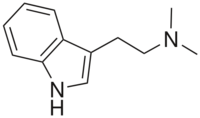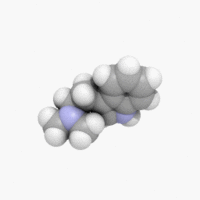Dimethyltryptamine
| Dimethyltryptamine | |
|---|---|

| |
| General | |
| Systematic name | 2-(1H-indol-3-yl)-N,N-dimethylethanamine |
| Other names | DMT or N,N-DMT |
| Molecular formula | C12H16N2 |
| SMILES | CN(CCC1=CNC2=C1C=CC=C2)C |
| Molar mass | Molar mass::188.269 g/mol |
| Appearance | White, crystalline solid |
| CAS number | CAS number::61-50-7 |
| Properties | |
| Density and phase | Density::1.099 g/ml, ? |
| Melting point | Melting point::40 °C |
| Boiling point | Boiling point::160 °C |
| Structure | |
| Crystal structure | Orthorhombic |
| Hazards | |
| MSDS | Material safety data sheet |
| Main hazards | Toxic if swallowed |
| Flash point | 154.7°C |
| R/S statement | R:25 S:22 |
| Related compounds | |
| Related compounds | 5-MeO-DMT, DET, tryptamine |
| Except where noted otherwise, data are given for materials in their standard state (at 25 °C, 100 kPa) Disclaimer and references | |
Dimethyltryptamine (DMT) is a hallucinogen that can cause people to see/hear things that aren't actually there. It was first used by the Indians in their religious rituals, and will induce sleep and an intense dream state. It is commonly known as the business man's trip because the drug lasts for only an hour. DMT is also released in your brain while you're in REM sleep and the last few seconds of your life when you are about to die. It is safe at normal doses and builds a low tolerance. You can trip multiple times in the same day. DMT is a Schedule 1 drug in the United States. That means it is illegal to manufacture, buy, or sell DMT.
Properties
Dimethyltryptamine is found in several plants, especially Prestonia amazonica (Apocynaceae) and in the brain, blood, and urine of mammals. It is a crystalline substance that in its purest form is clear. With impurities it is usually a hazy yellowish color. When light is shined on it, it reflects back brightly. When it has been made it has small spots with clear or yellowish shards (depending on the purity) sticking out of them. The tips of the shards usually form a sharp tip somewhat similar to an arrow. The shards are thin when initially formed. [1]
Synthesis / Occurrences
Dimethyltryptamine is a naturally occurring substance of the human blood, urine, cerebrospinal fluid , as well as in different types of plant species. It is also produced in our brain when we go into REM sleep. (7) and α,α-[2H]2-5-methoxy-N,N-dimethyltryptamine (10) and a convenient synthesis of [2H]4DMT (3) are all chemicals that are present in DMT. To make DMT you have to put a solution of indole-3-glyoxylic acid in ether to be stirred and cooled in a dry-ice bath for 15 min. SOCl2. was slowly added to the solution. The product was diluted with a large amount of dry ether and used directly without purification. Dimethylamine gas was passed through the ethereal solution for 1 to 3-5 min and that reaction was mixed for 20-30 min. Excess solvent was taken out to give 2 as a solid in 77% yield. [2]
Uses
Dimethyltryptamine is mainly used as a recreational drug. It is classified as a hallucinogenic drug, which means the user is likely to experience a distorted view of objects and reality. It's effects are similar to that of Lysergic acid diethylamide or Psilocybin mushroom. A number of cultures used to use DMT in spiritual ceremonies which led some people to consider DMT as being 'spiritual' and 'safe' rather than being a chemical hallucinogen. The effects of DMT include: immersive experiences, intense open eye visuals and kaleidoscopic patterning, powerful "rushing" of sensation, radical perspective shifting, profound life-changing spiritual experiences. [3]
Recreational Use
DMT was originally used by Indians to create hallucinogenic snuffs for their religious rituals. Now, it is commonly used for recreational use. It goes by names such as "the businessman's trip" or "one-hit grass". DMT, instead of providing a real trip to Psychedelic City, is more of a dropping-by-to-say-hi type of drug. The reason it is called the businessman's trip is because the journey begins almost instantly. It peaks within twenty or thirty minutes, and is over within an hour.
The first few minutes of the trip may be intensely: psychedelic followed by an increased heart rate and respiratory rates. You will experience nausea if you take DMT on a full stomach. Disorientation and confusion soon lead to the LSD-like effects, as the user usually floats through a variety of sensations such as: perceived color and size changes, visual, and time distortions, and an intoxicated, dizzy feeling combined with a feeling of increased caution and clear vision. The LSD-like effects are small in time, not affect.
Once the trip is over, there are no hangover or side effects, unless the user wasn't feeling good to begin with, or overdid the dosage. Moderation is the key. If you take the drug before you go to bed, falling asleep will be increasingly difficult.
Large doses of DMT may cause an excess amount of blood to rush to the brain, rupturing weak capillaries in the brain. The injection of DMT may cause the usual negative effects associated with introducing a non-sterile needle to the skin: infection, abscess, tetanus, gangrene, and malaria. Lethal overdose is unlikely, and it is neither chemically nor psychologically addictive.
The main danger with DMT is its action as a MAO inhibitor, meaning that when it is used in conjunction with the wrong things, it may result in dangerous changes in blood pressure, headache, heart trouble, or death. Substances that should be avoided when using DMT include: tranquilizers, amphetamines, atropine, ritalin, insulin, antihistamines, alcohol, avocados, broad beans (pods), excessive caffeine, canned figs,' chicken liver, sedatives, mescaline, nutmeg, aged cheeses, any quantity of milk products, ripe bananas, excessive chocolate, pickled herring, yeast extract, excessive licorice, pineapple, cocoa, narcotics, sauerkraut, ephedrine, macromerine, and oils of dill, parsley, and wild fennel. If you do combine it with any of the ingredients listed above, vomiting and strong headaches will be signs that you need to seek medical attention.
DMT is Schedule 1 in the United States. That means it is illegal to manufacture, buy, possess, or distribute without a DEA license. [4]
References
- ↑ Unknown Author. Showing metabocard for Dimethyltryptamine Human Metabolome Database. Web. February 8, 2013 (Last Updated).
- ↑ Morris Phillip Jr., and Chiao Cheng. Synthesis of Deuterated N,N-Dimethyltryptamine (DMT) and 5-Methoxy-N,N-Dimethyltryptamine (5-MeO-DMT) Erowid. Web. January 23, 2013 (Access Date).
- ↑ Unknown Author. DMT Erowid. Web. Apr 25, 2013 (Last Update).
- ↑ Young, Lawrence. DMT Drug Text. Web. March 4, 2010 (Date-of-Publication).
| ||||||||||||||



